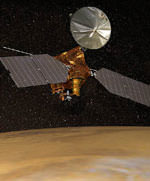
Image credit: NASA/JPL
Earth’s closest approach to Mars is past, but it’ll just be another two years until the planets are close together again – time to send more probes. Next up will be NASA’s Mars Reconnaissance Orbiter, which will make a detailed inspection of the Martian surface; imaging objects as small as a coffee table. It will also be able to scan underground layers for evidence of water and ice, and measure the atmosphere above the surface to find vents of water vapour escaping from below the surface. The spacecraft is expected to launch on August 10, 2005.
As Earth pulls away from Mars after last month’s close approach, NASA is developing a spacecraft that will take advantage of the next close encounter in 2005.
That spacecraft, Mars Reconnaissance Orbiter, will make a more comprehensive inspection of our planetary neighbor than any previous mission.
For starters, it will examine landscape details as small as a coffee table with the most powerful telescopic camera ever sent to orbit a foreign planet. Some of its other tools will scan underground layers for water and ice, identify small patches of surface minerals to determine their composition and origins, track changes in atmospheric water and dust, and check global weather every day.
“We’re reaching an important stage in developing the spacecraft,” said James Graf, project manager for Mars Reconnaissance Orbiter at NASA’s Jet Propulsion Laboratory, Pasadena, Calif. “The primary structure will be completed next month.” The structure weighs 220 kilograms (484 pounds) and stands 3 meters (10 feet) tall. At launch, after gear and fuel are added, it will support over 2 tons.
Also next month, the mission’s avionics test bed will be assembled for the first time and put to use for testing of flight software.
Workers at Lockheed Martin Space Systems, Denver, have already assembled the spacecraft structure and will later add instruments being built for it at the University of Arizona, Tucson; at Johns Hopkins University Applied Physics Laboratory, Laurel, Md.; at the Italian Space Agency, Rome; at Malin Space Science Systems, San Diego, Calif.; and at JPL.
“In several ways, Mars Reconnaissance Orbiter will advance NASA’s follow-the-water strategy for Mars exploration,” said Dr. Richard Zurek, project scientist for the mission.
Current surveys of Mars’ surface composition have found less evidence of water-related minerals than many scientists anticipated after earlier discoveries of plentiful channels that were apparently carved by water flows in the planet’s past. A spectrometer on the Reconnaissance Orbiter is designed to identify some different types of water-related minerals and to see smaller-scale deposits. “Instead of looking for something as big as the Bonneville Salt Flats, we can look for something on the scale of a Yellowstone hot spring,” Zurek said.
Probing below Mars’ surface with penetrating radar, Reconnaissance Orbiter will check whether the frozen water that NASA’s Mars Odyssey spacecraft detected in the top meter or two (yard or two) of soil extends deeper, perhaps as accessible reservoirs of melted water.
Above the surface, an atmosphere-scanning instrument will monitor changes in water vapor at different altitudes and might even locate plumes where water vapor is entering the atmosphere from underground vents, if that’s happening on Mars.
Mars Reconnaissance Orbiter will stream home its pictures and other information using the widest dish antenna and highest power level ever operated at Mars. “The amount of data flowing back to Earth from Mars will be a giant leap over previous missions. It’s like upgrading from a dial-up modem for your computer to a high-speed DSL connection,” Graf said.
The Mars Reconnaissance Orbiter will lay the groundwork for later Mars surface missions in NASA’s plans: a lander called Phoenix selected last month in a competition for a 2007 launch opportunity, and a highly capable rover called Mars Science Laboratory being developed for a 2009 launch opportunity. The orbiter’s high-resolution instruments will help planners evaluate possible landing sites for these missions both in terms of science potential for further discoveries and in terms of landing risks. The orbiter’s communications capabilities will provide a critical transmission relay for the surface missions.
Advantageous opportunities to launch Mars missions come in a rhythm of about every 26 months, shortly before each time Earth overtakes Mars in the two planets’ concentric tracks around the Sun. NASA’s two Mars Exploration Rovers and the European Space Agency’s Mars Express mission were launched during the three months preceding Earth’s most recent passing of Mars on Aug. 27. The Mars Reconnaissance Orbiter team has its work cut out for it to have the spacecraft ready for launch on Aug. 10, 2005, which is about 10 weeks before the next close approach.
Original Source: NASA/JPL News Release
